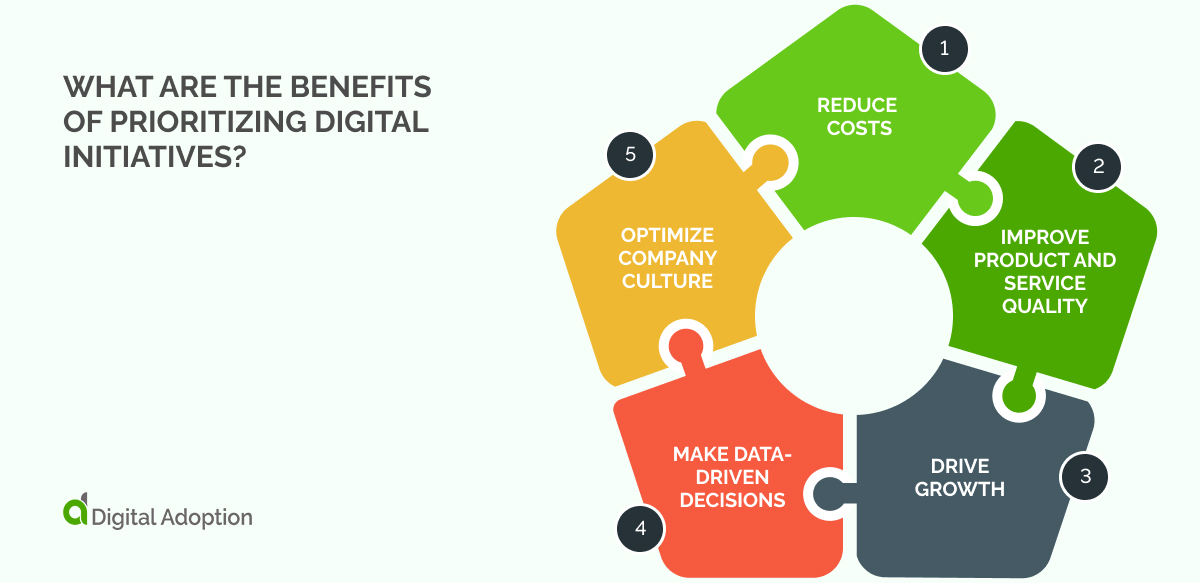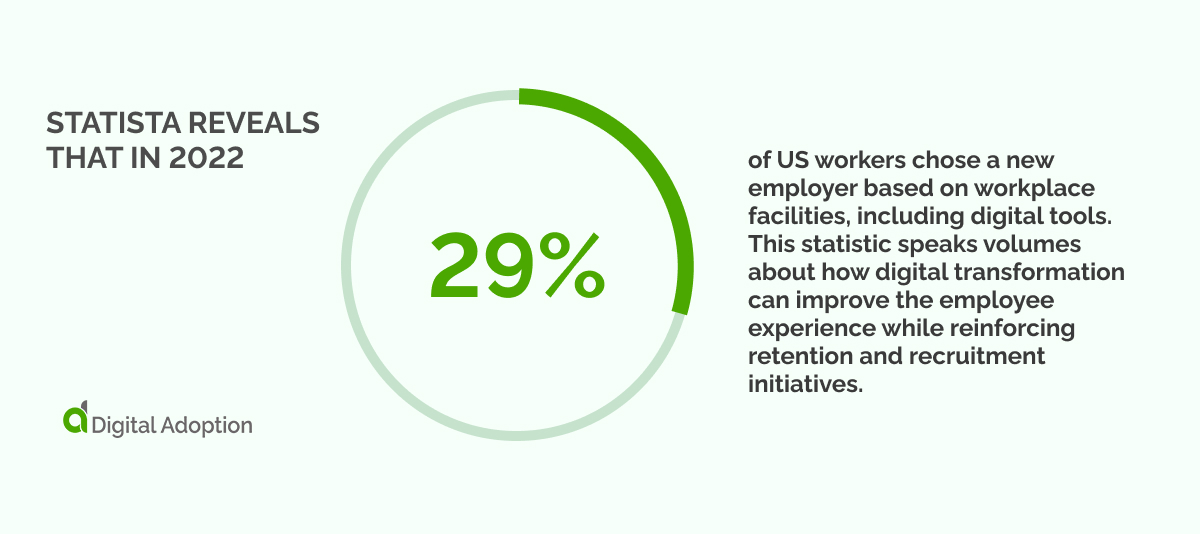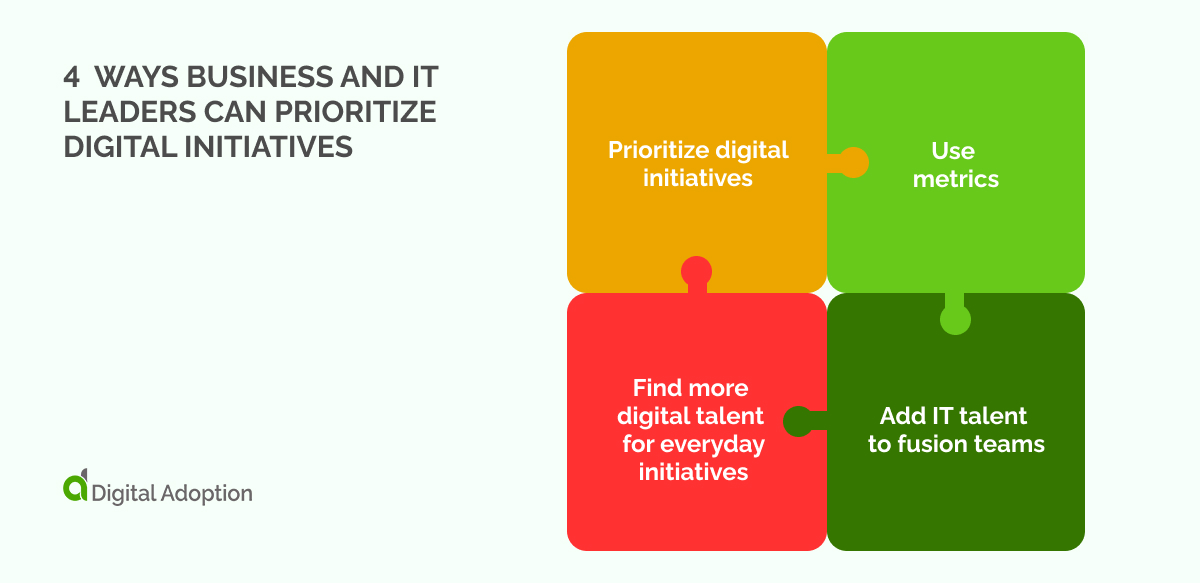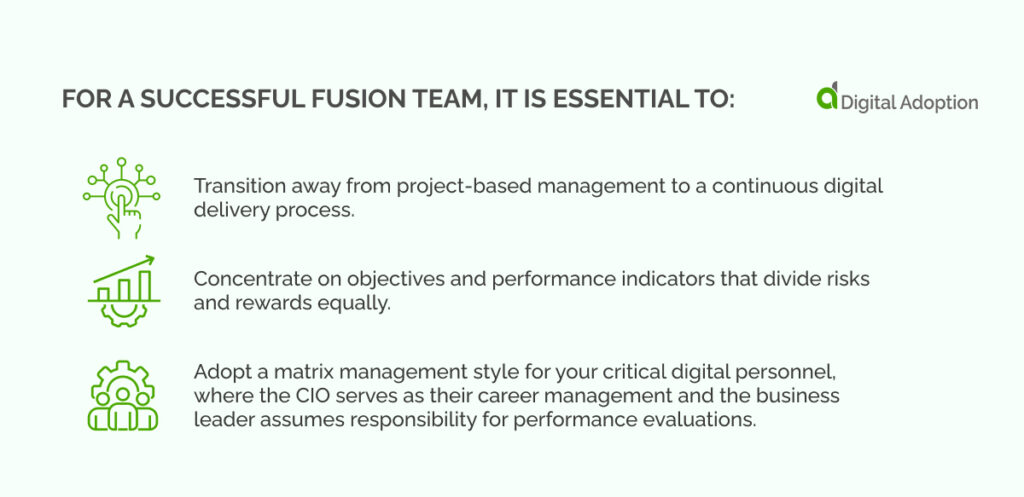There is a lot of discussion of digital transformation, but do you ever feel like you’re focusing on the wrong aspects of digital technologies to get the most out of them?
Concentrating on ways IT leaders can prioritize digital initiatives is the best way to ensure ROI growth, reduce staff frustration, and boost employee retention during your digital transformation.
This article explores the significance of prioritizing digital initiatives and offers four strategies for business and IT leaders to effectively prioritize them.
What is prioritizing digital initiatives?

Prioritizing digital transformation initiatives is when business and IT leaders ensure that digital initiatives are always at the forefront of the organization in all business processes. Prioritizing digital initiatives ensures ROI on costly initiatives for digital transformation success.
Why is prioritizing digital initiatives important?
When organizations do not prioritize digital initiatives, investment is lost, and companies do not evolve to meet the changing needs of customers and staff. On the other hand, when digital initiatives are prioritized, companies develop and shift to meet customers’ changing needs as the team learns to use new digital tools. Doing so leads to success, growth, and a long-term positive attitude toward innovation and digital resilience as part of the company culture.
What are the benefits of prioritizing digital initiatives?

There are many benefits of prioritizing digital initiatives, beginning with reducing costs.
Reduce costs
Cost efficiency is the most typical incentive behind digital transformation; Gartner research reveals that organizations launch almost two-thirds of digital transformation initiatives with cost savings in mind. By utilizing digital technology, firms can maximize asset use, boost employee productivity, reduce overhead and production costs, and optimize after-market service.
Improve product and service quality
High-quality products and services set companies apart in any market. Digital initiatives allow businesses to achieve closed-loop quality by implementing strategies, technologies, and more effective decision support system that reduce rework and scrap and promote traceability across the value chain while providing consistent first-time resolutions.
Drive growth
Initiatives focused on growth can have a powerful, transformative effect on business. Digital transformation doesn’t simply involve minor changes to existing goods and processes but instead focuses on discovering novel ways of gaining income within the company – this could include new products, fresh revenue streams, or even additional productivity and output.
Make data-driven decisions
Using precise, accurate, and contextualized data can enlighten all departments of an organization to lead to better decision-making as part of their digital initiatives. Generally, in digital transformation projects, companies aim to gain enhanced insights from their data and provide feedback throughout the product life cycle across the business.
Optimize company culture

Statista reveals that in 2022, 29% of US workers chose a new employer based on workplace facilities, including digital tools. This statistic speaks volumes about how digital transformation can improve the employee experience while reinforcing retention and recruitment initiatives.
4 Ways Business and IT Leaders Can Prioritize Digital Initiatives

Business and IT leaders today are under pressure to identify and prioritize digital initiatives that can help their organizations become more competitive, efficient, and profitable.
Here are four key ways they can do this, starting with prioritizing digital initiatives.
1. Prioritize digital initiatives
Many digital initiatives can deliver digital dividends, but to focus on the right areas, ask yourself:
- Will the business’s digital initiatives provide the financial outcomes the CEO targets, particularly given today’s dynamic economic environment?
- Is the enterprise achieving its desired outcomes in the timeline set out by the CEO? With a challenging economy, it is imperative to begin reaping the rewards quickly.
Asking yourself these questions helps you prioritize digital initiatives to drive your transformation toward success.
Tips for success
Pay close attention to the priorities and worries of top executives, then join forces with an individual in your business who is just as committed as you are to an initiative that answers a significant priority.
When scouting for the ideal business executive to be your partner, seek an individual with superior characteristics. Afterward, collaborate with them to decode any signals and pinpoint the most beneficial initiatives that need pursuing and difficulties that you must remove.
2. Use metrics
Measuring progress and benefits is essential for success. Each individual contributing to the outcome has their achievement metrics. Doing so can complicate financial recognition from a broader business perspective. It remains critical that these figures are kept in check to ensure overall success.
For instance, the IT team may set internal operational metrics that are difficult to connect with how they influence organizational success.
It is crucial to ask the CFO which financial metrics to enhance through digitization, how much advancement they expect, and in what timescale.
To drive financial performance, Chief Information Officers must illustrate the connections between digital projects that may operate in isolation but are connected. For example, how can indirect operational initiatives fuel direct market-facing business goal measurements?
Tips for success
Connecting technical performance metrics with business results, identify every participant’s contribution and initiative to your company objectives. Although lower-level metrics are not as direct, they all funnel toward more meaningful goals. This hierarchy of metrics produces an impressive digital dividend for banking, exemplifying our successes in this sector.
3. Add IT talent to fusion teams
To maximize results, CIOs should provide education and talent to the business leader in charge of a high-impact digital initiative. An efficient fusion team, also known as a cross-functional team, brings together subject matter experts, business technologists, and IT professionals, emphasizing achieving desired outcomes – increasing productivity while reducing time to market.

For a successful fusion team, it is essential to:
- Transition away from project-based management to a continuous digital delivery process.
- Concentrate on objectives and performance indicators that divide risks and rewards equally.
- Adopt a matrix management style for your critical digital personnel, where the CIO serves as their career management and the business leader assumes responsibility for performance evaluations.
Tips for success
As the CIO’s representatives, IT members of a business-led fusion team are responsible for recognizing and communicating necessary capabilities, data, and technologies that their corporate initiative requires.
By leveraging this information, the Platform Product Manager under the CIO can build digital platforms that offer solutions to other teams in need – creating an ongoing feedback loop that will catalyze further meaningful action.
By including IT talent in the company-driven fusion team, we can create an environment of mutual collaboration. For example, this could involve integrating knowledge experts from the business into a technology-led fusion group.
4. Find more digital talent for everyday initiatives
Despite economic hardship, the hunt for digital talent remains as competitive as ever. Fusion teams are now starting to reap the rewards from their efforts, and CIOs still must employ qualified digital personnel to complete lower-priority internal initiatives.
Through our research, we have discovered a plethora of potential talent sources suitable for this type of work that are largely untapped. For instance, only some organizations use the student demographic or collaborate with industry competitors to fill essential yet undistinguished business abilities. Moreover, few use gig workers, either.
Tips for success
As fusion teams tackle intricate digital initiatives, IT executives can explore alternative talent recruitment strategies to advance everyday digital commitments further.
Surprisingly, organizations can acquire numerous unconventional means at no or minimal cost (such as through interns). To procure unique talent, CIOs must prepare to allocate additional time and resources for supervision and training. Adopting the correct mindset of collaboration coupled with competition is also essential.
As an alternative to monetary compensation, CIOs must consider experience, exposure to new skill sets, or payment based on deliverables in organizations with unionized labor who actively engage with their respective union leaders.
IT professionals and HR teams can collaborate to develop new job descriptions and discern outdated policies that may prevent the firm from quickly bringing on gig workers or others to create a diverse work atmosphere.
Share skills to prioritize digital initiatives successfully

As an IT leader, you have a lot on your plate when leading digital initiatives in today’s ever-changing tech environment, where new technologies are necessary for success. Optimizing those initiatives and focusing on the critical success factors will help ensure your organization meets its goals.
With a clear plan of action surrounding cost efficiency, security, scalability, and customer experiences, IT leaders can reap the benefits of utilizing cutting-edge technology while keeping initiative performance high as they focus on the health of the company culture. Ownership of these areas is critical for success as you share skills with every team and department.













